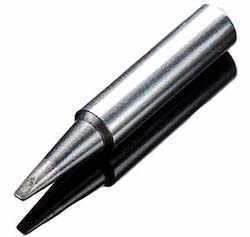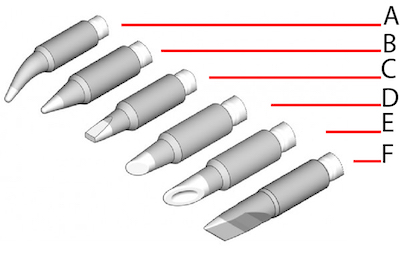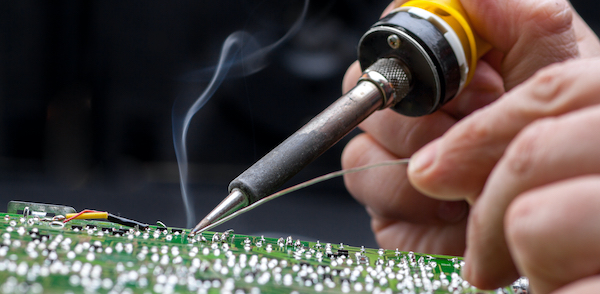Different Types of Soldering Iron Tips
Mục Lục
Different types of Soldering Iron Tips

Figure 1: Soldering tip
A soldering iron is a tool used for soldering. Soldering is the process of bonding pieces of metal together. A connection is established between two metals with the addition of a filler metal, called solder. The filler metal has a very low melting point, which ensures that the metals or the surfaces to be joined are not melted during the process. Solder usually consists of silver and tin or lead.
The hot iron tip is used to create the welding joint, which aids in melting the filler metal that eventually solidifies, resulting in an electrically conductive joint and holding the joint mechanically together. Soldering is mainly used to join wires or thin plates and to ensure a tight connection on PCBs. See the various types of soldering iron tips and a general introduction to the process of soldering below.
Types of soldering iron tips
Choosing the correct soldering iron tip for an application is crucial to the outcome of the soldering. In addition to different types, they come in different sizes. If the tip is too big, the solder my flow from one point to another creating an unattended solder bridge (a short). However, proper care is also important, a well maintained tip will last longer. See the top 5 common soldering tips below:

Figure 2: Types of soldering iron tips
- Needle (I-series) Tips (A): The ends of a needle tip are pointed, and hence suitable for applications that involve very high detail. The surface area at the end of this tip is very small, hence it is not suitable for soldering large components.
- Conical (B-series) Tip (B): A conical tip has a conical taper with a rounded end and delivers heat to a small defined area. The tip can be used for flexible applications and the soldering can be performed from any angle. Conical tips are used for general purpose applications.
- Beveled Tip (C): A beveled tip is similar to a conical tip with two of its ends flattened to resemble a ground-up pencil. The flat sides can hold more solder as compared to a conical tip and can be used to transfer a lot of heat to more demanding joints. A beveled tip is highly versatile, hence useful for everyday use.
- Chisel (D-series) Tip (D): A chisel tip is similar to a beveled tip, but only one side is flattened. The tip resembles a chisel and has a larger surface area compared to a conical tip. These tips are used in applications that require a lot of heat transfer, like soldering thick wires, or even desoldering.
- Hollow Point tip (E): Similar in looks to the chisel type tips, these tips allow for correcting bridging. The tips have a spherical indentation where the chisel type is flat.
- Knife (K-series) Tip (F): A knifetip has a slanted tip, thus resembling the shape of a knife. These tips are typically used for drag soldering, where the tip is dragged across many pins on an integrated circuit, to increase the soldering accuracy and efficiency. A knife tip is also suitable to fix solder bridges.
Specialized tips
Certain manufacturers make specialized tips, for example, the spade-shaped tip is used to cut off glue from glass surfaces like an LCD screen.
How to solder a component to the PCB (Printed Circuit Board)

Figure 3: The soldering process
Perform the following steps to solder a component to the electronic board:
- Place the component in the hole on the board as per the marking, and fix it in the position by bending the leads.
- Switch on the power supply of the soldering iron and wait for the tip to get heated. This might take a few minutes.
- Place the solder on the board and touch the tip of the iron on the solder for a second so that it melts.
- Remove the iron and solder wire.
- Check whether the joint formed by the solder is proper. A good solder joint will be conical in shape. If the shape is not formed correctly, cut off the component lead and perform the process once again.
- If the solder forms sticky chunks instead of getting melted properly, it might be due to oxidation at the soldering iron tips. Tinning the iron is highly recommended, at least before and after the soldering process.
To learn more about soldering read our article on soldering stations. In our technical information center you can also find information on products such as clamp meters, thermal imaging cameras, and more.
Frequently asked questions
How long should a soldering iron tip last?
If the soldering iron is free from any sort of mechanical or electrical damage, the tip can last for years. Getting the soldering iron from a known brand is crucial to ensure a decent lifespan.
How do I know if my soldering iron is hot enough?
The soldering iron tip makes a ‘hiss’ sound upon heating up, and the absence of the sound means that the tip is not hot enough to melt the solder.
Why does my solder burn?
Overheating burns and destroys the solder, hence it is crucial to keep the soldering iron at an optimum temperature while working.















![Toni Kroos là ai? [ sự thật về tiểu sử đầy đủ Toni Kroos ]](https://evbn.org/wp-content/uploads/New-Project-6635-1671934592.jpg)


